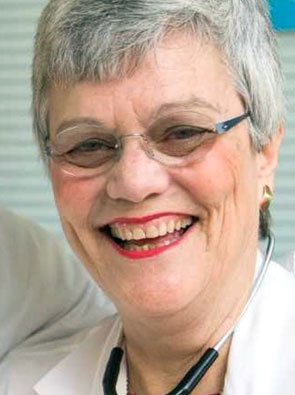
Improvement
New standards ensure pediatric candidates receive the best care possible
More than 260 pediatric transplant programs meet recently updated requirements designed for the specific needs of children
More than 1,600 pediatric patients—ranging in age from infants to high school seniors—received an organ in 2020, a record-setting year for deceased donor organ donation and transplantation.
Over the years, dedicated doctors have saved the lives of thousands of children like Madelyn. Pediatric patients have much smaller bodies than adult patients—and their anatomies require specialized approaches. As Heung Bae Kim, M.D., explains: “Pediatric transplant patients have different diseases than adults, and their care requires different expertise.”
Kim directs the Pediatric Transplant Center at Boston Children’s Hospital and serves as a professor of surgery at Harvard Medical School. A former chair of the OPTN Pediatric Transplantation Committee and current vice-chair of the Membership and Professional Standards Committee, he also approaches transplant from a parent’s perspective, asking questions such as “Would you want your two-year old being taken care of by an internist?”
“Pediatric transplant requires a team of people who specialize in that care,” Kim said.
Ensuring the smallest patients have the best care
In December 2020, new requirements went into effect to ensure that the surgeons and physicians caring for pediatric candidates have the necessary experience in pediatric transplantation. These changes mean that in order to have an approved pediatric component, a transplant program must show that its primary pediatric physician and primary pediatric surgeon meet certain criteria, respective to organ type. An emergency exception pathway exists to allow adult heart and liver programs to register a patient under the age of 18 in urgent circumstances.
“This is a key milestone in promoting the safety and efficiency of transplantation for children in need of a transplant,” said OPTN Board of Directors president David Mulligan, M.D. “The requirements were developed carefully to ensure that these programs have highly trained and experienced clinical staff and appropriate facilities to care for the specific needs of pediatric candidates and recipients.”
Developing pediatric policies
As early as 1993, both the pediatric committee and the MPSC began attempting to define the elements of a pediatric transplant program and thinking about what requirements should be involved. In 2010, the MPSC made it a priority, and in 2012 the board made it a key initiative.
OPTN members play a key role in the decision-making process, developing policies together in committees that then propose changes to the board. These policies also go through at least one public comment period so that all stakeholders—including patients and families—can provide input. Committee support staff at United Network for Organ Sharing help the committee volunteers draft policy and collect the data that helps inform their work.
Every transplant hospital program in the U.S. is an OPTN member, and every program has to meet key personnel requirements related to their primary surgeon and primary physician—including what and how much experience they have with certain practices and procedures.
“This proposal had extensive development through all of the organ transplant community,” said Brewer, who has been performing pediatric kidney transplants for 40 years. “The process incorporated the perspectives of everybody, not just those on committees, but also people in the larger transplantation community. Everyone worked together to make sure that children have access to transplantation from those who are trained to do transplants in children.”
She also explained that the addition of the emergency pathway exception requirements was a safeguard so that an adult program could transplant a pediatric candidate in urgent circumstances.
MPSC: Promoting patient safety
Kim, who is currently finishing a two-year term as vice-chair of the MPSC, likewise stressed the importance of patient safety when discussing the committee’s role in the changes to the bylaws. As an operating committee of the OPTN, the MPSC develops and maintains membership criteria while supporting members and guiding their improvements to make sure they follow policies and bylaws. The drive to develop pediatric requirements was initiated by the MPSC because the older bylaws allowed people with expertise mainly in adult care to become primary personnel for pediatric programs.
“One of our jobs as the MPSC is to work with UNOS’ Member Quality Department to look at the bylaws and policy, and find things that were maybe appropriate in an earlier era, but that have become inconsistent, or perhaps don’t make sense now,” Kim said. “We see what we can do to change and improve them.” He added that the committee is currently reviewing all OPTN bylaws for consistency. “It’s a bit like a tax code, in that over the years things get added on,” Kim said. “Every now and then you have to take a step back and look at the entirety for appropriateness and consistency. Things written in the 1980s and 1990s may not be appropriate or relevant anymore.”
Brewer said the pediatric requirements project was one of the longest she undertook during her committee service. “I have to say that achieving this goal would not have been possible without the foresight of the MPSC and the board to make it a priority,” she said. “The pediatric committee then worked hard to define acceptable program requirements that would ensure quality and outcomes for pediatric patients.”
The timeline for development of pediatric standards
1984
The National Organ Transplant Act charges the OPTN to “recognize the differences in health and an in organ transplantation issues between children and adults throughout the system ad adopt criteria, policies and procedures that address the unique needs of children.”
The pediatric committee and the MPSC begin attempts to define elements of a pediatric program.
1993
2000
Children’s Health Act of 2000 includes an amendment to clarify that, for the purposes of OPTN work pertaining to children, “children” refers to individuals who are under the age of 18.
MPSC sets an annual goal of developing qualification criteria for pediatric organ transplant approval.
2010
2012
OPTN Board of Directors includes the development of separate program requirements for pediatric programs as a key initiative under Goal 4: Promote Patient Safety of the OPTN’s strategic plan at that time. The key component of a program that performs transplants in children less than 18 years old is the identification of a qualified primary pediatric surgeon and a qualified primary pediatric physician to serve as the “key personnel.”
The pediatric committee sends a formal notice to the OPTN organ-specific committees requesting their feedback on fundamental questions for structuring the pediatric proposal, in addition to the American Society of Transplantation, the American Society of Transplant Surgeons, and the International Society for Heart and Lung Transplantation. The committee presented the original proposal to the regional meetings that fall.
2013
2014
The pediatric committee shared modified requirements in an update at the summer regional meetings. In December both the MPSC and pediatric committee approved the proposal for 60 days of public comment scheduled for early 2015.
After public comment closed, the proposal was presented to the OPTN Board of Directors in June 2015 and sent back to the pediatric committee for further refinement in collaboration with ASTS and AST. Following a second presentation to the board in December 2015, the board adopted the proposal as policy.
2015
2017
After a public comment period, the board approved an emergency exception pathway for adult heart and liver programs in cases involving extenuating circumstances.
At its Dec. 7 meeting, the board approves pediatric components for 268 transplant programs. The searchable member directory displays programs with a pediatric component.
2020
Partnering with Member Quality
Throughout the pediatric bylaws project, UNOS’ member quality team provided guidance to the committees and to program applicants to help shepherd the project to its implementation in December. “We wanted to ensure a seamless transition, to make sure these pediatric programs could be up and running on the implementation date,” said Jacqueline O’Keefe, director of UNOS’ Department of Member Quality. “Our staff worked closely with members to aid in completing these applications and the review process.”
A partner in improvement, UNOS Member Quality helps all OPTN members—organ procurement organizations, transplant programs and histocompatibility labs—use effective practices to save more lives. Through collaboration and education, member quality works with members to deliver patient safety and transplant system integrity while supporting the MPSC peer review process that is so important to the community.
“Making sure children receive the best care possible is so important,” reflects Kim. “When you serve on a committee, you will be working on things that matter. The things we do ripple across the country, and I’ve not found that mission focus in any other organization I’ve been involved with.”
The number of OPTN committees and committees of the board. Donation and transplant policies are developed by the community, together.
OPTN members play a key role in the decision-making process, developing policies together in committees that then propose changes to the board. These policies also go through at least one public comment period so that all stakeholders—including patients and families—can provide input.
Committee support staff at United Network for Organ Sharing help the committee volunteers draft policy and collect the data that helps inform their work.
“The process incorporated the perspectives of everybody, not just those on committees, but also people in the larger transplantation community.”
Eileen Brewer, M.D.



